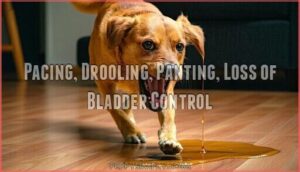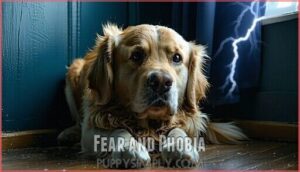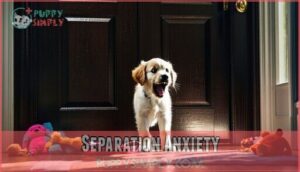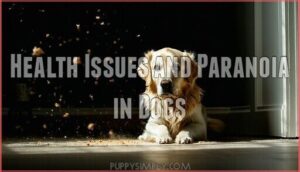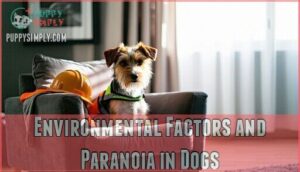This site is supported by our readers. We may earn a commission, at no cost to you, if you purchase through links.
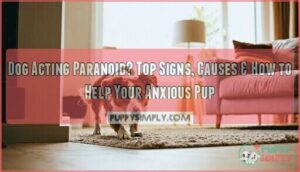 When your dog’s acting paranoid, you’re seeing stress responses like excessive pacing, trembling, hiding, or sudden behavioral changes that affect nearly half of all dogs.
When your dog’s acting paranoid, you’re seeing stress responses like excessive pacing, trembling, hiding, or sudden behavioral changes that affect nearly half of all dogs.
This paranoia stems from various triggers including fear, separation anxiety, past trauma, medical conditions, or environmental changes like new sounds or objects in your home.
Physical symptoms often include drooling, panting, and loss of bladder control during episodes.
Senior dogs may develop paranoia due to nervous system changes, while acute poisoning can cause sudden behavioral shifts.
The key is identifying whether the cause is psychological, medical, or environmental.
Management involves creating secure environments, positive training techniques, and sometimes professional intervention.
Understanding your dog’s specific triggers and providing consistent, patient support helps restore their confidence and sense of security in their surroundings.
Table Of Contents
- Key Takeaways
- Signs of Paranoia in Dogs
- Common Causes of Dog Paranoia
- Health Issues and Paranoia in Dogs
- Environmental Factors and Paranoia in Dogs
- Managing and Treating Dog Paranoia
- Understanding and Supporting a Paranoid Dog
- Frequently Asked Questions (FAQs)
- Why do dogs act paranoid all of a sudden?
- Why is my dog suddenly paranoid and jumpy?
- Why does my senior dog have paranoia?
- Why is my Dog scared and acting paranoid?
- How do you know if a dog is paranoia?
- Why is my dog with PTSD paranoid?
- Why is my dog acting weird and scared of me all of a sudden?
- Why is my dog looking around paranoid?
- Why has my dog started acting weird?
- Can dogs develop paranoia from medication side effects?
- Conclusion
Key Takeaways
- Identify the root cause – You’ll need to determine if your dog’s paranoia stems from medical issues, past trauma, or environmental changes before you can effectively treat it.
- Watch for physical symptoms – You should look for signs, such as excessive pacing, drooling, panting, and loss of bladder control, that indicate your dog is experiencing stress-related paranoia.
- Create a secure environment – You can help your paranoid dog by establishing safe spaces, maintaining predictable routines, and removing anxiety triggers from their surroundings.
- Seek professional help when needed – You shouldn’t hesitate to consult a veterinarian or certified behaviorist if your dog’s paranoia persists, worsens, or interferes with their daily functioning.
Signs of Paranoia in Dogs
You’ll notice specific behavioral changes when your dog starts acting paranoid, ranging from physical symptoms to dramatic shifts in their normal routine.
These signs often appear together and can help you identify whether your pup is experiencing anxiety or fear-based paranoia.
Pacing, Drooling, Panting, Loss of Bladder Control
Physical distress manifests through unmistakable anxiety symptoms when your dog experiences paranoia.
Your dog’s body reveals their emotional turmoil through undeniable physical signs of distress.
You’ll notice these clear behavioral manifestations that signal your pet’s fear response:
- Pacing and restlessness – Your dog can’t settle down and walks repeatedly in circles or back and forth
- Excessive drooling and panting – Even when it’s not hot, your dog’s mouth produces excess saliva and breathing becomes labored
- Loss of bladder control – Involuntary urination occurs despite normal house training
These dog paranoia signs indicate your pet feels overwhelmed by perceived threats.
Dog anxiety symptoms often appear together, creating a pattern of dog stress signs that’s hard to miss.
When dogs act scared, their bodies respond automatically through these fear responses.
The combination of these behaviors suggests your dog’s nervous system is in overdrive, preparing for danger that may not actually exist.
Understanding these anxiety in dogs helps you recognize when your pet needs support and intervention.
Note that breathing rate over 30 can be a sign of a more serious issue.
Sudden Changes in Behavior
Beyond the physical symptoms like pacing and drooling, you’ll notice your dog’s entire personality can shift when paranoia sets in. Sudden aggression toward family members or other pets often catches owners off guard. Your once-friendly pup might snap at children or growl when approached.
Sleep patterns become erratic – your dog may pace all night or hide under furniture during normal rest hours. Appetite changes range from complete food refusal to protective guarding of bowls. Activity levels drop dramatically as fearful dogs withdraw from normal play and exercise.
Social interaction suffers most. Dogs experiencing sudden fear avoid eye contact, refuse commands, and seek isolated spaces. These dog behavior changes signal deep emotional distress.
| Behavior Type | Normal State | Paranoid State |
|---|---|---|
| Sleep Pattern | 12-14 hours daily | Restless, frequent waking |
| Appetite Changes | Regular eating | Food refusal or guarding |
| Activity Level | Playful, energetic | Withdrawn, lethargic |
| Social Interaction | Friendly, responsive | Avoidant, defensive |
| Sudden Aggression | Rare, predictable | Unprovoked, frequent |
Paranoid symptoms develop gradually or appear overnight, making early recognition essential for your dog’s wellbeing.
Common Causes of Dog Paranoia
Your dog’s paranoid behavior often stems from three main causes that can overlap and reinforce each other.
Fear-based paranoia develops when dogs experience phobias from loud noises, unfamiliar objects, or traumatic memories, while separation anxiety creates intense distress when left alone.
Past trauma from abuse or neglect can trigger lasting paranoid responses to specific situations or stimuli, and these causes can combine to create complex paranoid behavior in dogs, driven by fear-based reactions.
Fear and Phobia
Fear and phobias create deep-rooted anxiety in dogs, leading to paranoid behaviors that seem irrational.
Your dog’s breed predisposition influences their noise sensitivity and overall anxiety levels. Trauma triggers from past experiences can resurface unexpectedly, causing intense fear responses.
Poor socialization impact during puppyhood increases vulnerability to developing irrational phobias later in life. Common dog anxiety triggers include thunderstorms, fireworks, and unfamiliar environments.
These dog paranoid symptoms manifest as excessive vigilance and defensive behaviors. Understanding your dog’s specific dog fear patterns helps identify underlying dog phobia causes.
Addressing these root causes through gradual exposure and positive reinforcement builds confidence and reduces paranoid episodes, ultimately leading to a more stable and less anxious life for your dog, by tackling the root causes.
Separation Anxiety
When your dog can’t handle being alone, separation anxiety transforms everyday departures into emotional storms.
This intense fear of abandonment creates a cycle where your pup’s world revolves around your presence, making even brief absences feel catastrophic.
Dogs with separation anxiety exhibit distinct patterns:
- Destructive behaviors like chewing furniture, scratching doors, or shredding household items within minutes of your departure
- Clingy behavior including following you everywhere, refusing to settle unless you’re nearby, and showing distress when you prepare to leave
- Physical symptoms such as excessive panting, drooling, pacing, or loss of bladder control during your absence
This dog anxiety often stems from insufficient alone time training during puppyhood or traumatic experiences like rehoming.
Your dog’s nervous behavior escalates quickly without proper intervention.
Calming techniques like gradual desensitization can help, but severe cases require professional intervention.
A veterinary behaviorist can distinguish separation anxiety from other causes of dog acting scared and develop targeted treatment plans for your pet’s specific needs.
Traumatic Experiences or Past Trauma
When traumatic events like abuse or abandonment occur, your dog’s brain creates lasting memory associations that trigger paranoia.
These bad memories can cause PTSD-like symptoms, making your dog hypervigilant and fearful.
Rescue dog trauma often manifests as sudden behavioral changes when encountering specific triggers.
Common PTSD triggers include loud noises, certain movements, or unfamiliar objects.
Understanding these trauma responses helps you recognize when your dog’s paranoia stems from past experiences rather than current threats, allowing you to approach trauma recovery with patience and appropriate interventions.
Health Issues and Paranoia in Dogs
Sometimes your dog’s paranoid behavior isn’t just anxiety—it could signal an underlying health problem that needs attention.
Medical conditions ranging from neurological disorders to metabolic imbalances can trigger sudden fear responses and paranoid-like symptoms in dogs.
Medical Conditions That Can Cause Anxiety
Various medical conditions can trigger anxiety in your dog, making early detection vital for their wellbeing.
These health problems often manifest as paranoid behaviors that mimic psychological issues but require medical treatment.
Here are five key medical conditions that cause anxiety in dogs:
- Thyroid Imbalance – Hypothyroidism disrupts brain function and increases anxious behaviors
- Neurological Disorders – Epilepsy and brain inflammation affect mood and cause fearfulness
- Chronic Pain – Arthritis and injury create ongoing discomfort that leads to paranoia
- Cognitive Decline – Senior dogs experience confusion and anxiety from brain changes
- Fly-biting Disorder – Seizure-related condition causes dogs to snap at invisible objects
Pain Management becomes essential when physical discomfort drives anxious behaviors.
Dog Mental Health improves substantially once underlying Health Problems receive proper treatment from your veterinarian.
Nervous System Disease in Senior Dogs
Why does your senior dog suddenly seem anxious or confused?
Cognitive decline affects 14-35% of dogs over eight years old, causing disorientation and altered behavior.
Senior dogs may develop neurological problems like seizure disorders or canine cognitive dysfunction, leading to dog nervous behavior.
Aging brings sensory changes that increase anxiety and paranoia.
Pain management becomes essential as arthritis and other conditions affect mobility.
While dogs can develop various genetic disorders, they can’t develop Down syndrome itself.
These neurological problems require veterinary assessment to distinguish between normal aging and serious disease.
Early intervention helps maintain quality of life, though end-of-life care considerations become important as conditions progress.
Acute Poisoning and Sudden Behavioral Changes
Toxic substances can trigger immediate paranoia and sudden behavioral changes in your dog.
When poisoning occurs, neurotoxins disrupt brain function, causing anxiety, tremors, and disorientation alongside physical symptoms like excessive drooling and vomiting.
Common culprits include rodenticides, pesticides, household chemicals, and certain plants that interfere with your dog’s nervous system.
Recognizing poisoning symptoms requires immediate action.
Watch for sudden restlessness, loss of coordination, and seizures combined with dog paranoid behavior.
These health issues demand emergency veterinary diagnosis since toxic exposure can cause fatal outcomes without prompt treatment.
Your vet will use toxicology screening and clinical signs to identify the specific poison.
Treatment involves decontamination, activated charcoal, and supportive care to prevent long-term effects on your dog’s mental state and overall well-being.
Environmental Factors and Paranoia in Dogs
Your dog’s environment plays a major role in triggering paranoid behaviors, as sudden changes can overwhelm their sense of security.
New furniture, unfamiliar sounds, or even rearranged rooms can cause your pup to act suspicious and fearful of their once-comfortable surroundings, leading to a breakdown in their sense of security.
Changes in The Environment Triggering Fear
When your dog encounters a New Home or faces Rearranging Furniture, their world feels upside down.
Moving Stress and Travel Anxiety intensify fearful dog behavior as familiar scents and layouts disappear.
Construction Sounds amplify these environmental changes, creating fear triggers that cause dog paranoid behavior causes to surface.
Your pup’s anxiety stems from losing their mental map of safety and comfort, which can be triggered by fearful dog behavior.
Unfamiliar Noises and Stressors
Thunderstorms can trigger your dog’s paranoid behavior, especially when sudden sounds catch them off guard.
Dogs experience noise sensitivity differently than humans, making unfamiliar noises particularly distressing.
New environments compound this stress, creating sensory overload that overwhelms their nervous system.
Understanding common dog fear triggers helps you recognize when your pup needs support:
- Sudden Sounds – Fireworks, construction noise, or unexpected crashes can cause immediate panic responses
- Environmental Changes – Moving to new locations or altered household routines disrupt their sense of security
- Sensory Overload – Multiple stressors occurring simultaneously amplify anxiety levels substantially
Dog paranoid behavior causes often stem from their heightened hearing abilities.
They detect frequencies we can’t hear, making seemingly quiet moments stressful for them.
Dog anxiety causes include both genetic predisposition and learned responses to past traumatic experiences.
Stress reduction techniques work best when applied consistently.
Creating predictable routines helps manage their anxiety effectively.
New Objects or Changes in The House
Even small changes can trigger massive anxiety in sensitive dogs.
New furniture, rearranging rooms, or remodeling effects introduce unfamiliar smells and disrupt your dog’s mental map of home.
These new objects become anxiety triggers, especially when combined with changes to the owner’s routine.
Your pup’s heightened vigilance stems from uncertainty about these environmental shifts, requiring patience and gradual exposure for effective dog anxiety treatment.
A predictable routine is key, as is understanding common causes of fear.
Managing and Treating Dog Paranoia
Once you’ve identified the signs and causes of your dog’s paranoia, you can take steps to help them feel more secure and confident.
With the right approach, most dogs can overcome their fears and return to their normal, happy selves.
Crate Training and Desensitization
Building a strong foundation for your paranoid dog starts with creating a safe space where they can learn to face their fears gradually.
Crate introduction should be positive and voluntary, never forced, allowing your dog to explore at their own pace. This approach transforms the crate from a scary confinement into a secure retreat where your anxious pup can decompress.
Desensitization methods work best when combined with crate training, creating controlled environments for gradual exposure to triggers.
Here’s how to implement effective dog anxiety treatment:
- Start with short sessions – Begin with 5-10 minutes of voluntary crate time with the door open
- Use high-value treats – Create positive associations by offering special rewards only during crate time
- Introduce triggers slowly – Play recordings of scary sounds at low volumes while your dog relaxes in their crate
- Monitor stress signals – Watch for panting, drooling, or attempts to escape and adjust accordingly
This systematic approach to desensitization helps reduce dog paranoid behavior while building confidence through predictable, positive experiences.
Many owners find success with proper crate introduction, making the process easier.
Positive Training Techniques
Positive training techniques work wonders when your anxious pup needs a confidence boost.
Reward-based methods using treats, praise, and toys help your dog associate good behavior with positive outcomes.
Counter-conditioning changes your dog’s emotional response to triggers by pairing scary situations with something pleasant.
Desensitization gradually exposes your dog to fear triggers at low intensity levels.
Building confidence happens through consistent positive reinforcement during training sessions.
Dog behavior modification requires patience, but these techniques effectively reduce anxiety over time.
Regular practice strengthens the bond between you and your pet while teaching them that the world isn’t as frightening as it seems.
Remember, consistency is key for successful dog anxiety treatment.
Many owners find success using positive reinforcement methods.
Seeking Professional Help if Needed
Sometimes your dog’s paranoia crosses the line from manageable concern to serious distress.
Professional Assessment becomes vital when behavioral issues persist despite your best efforts.
A Veterinary Behaviorist can diagnose underlying medical conditions while providing thorough behavior modification plans.
Consider seeking expert help when you notice these warning signs:
- Severe aggression or self-harm – Your dog’s fear responses threaten their safety or others’
- Complete withdrawal from normal activities – They refuse walks, meals, or social interaction
- Medication Options become necessary – Anxiety prevents basic functioning despite environmental changes
Your veterinarian can determine if you’ve reached the Severity Threshold requiring professional intervention.
They’ll coordinate with a certified dog trainer to create targeted Training Support strategies.
This collaborative approach addresses both medical and behavioral aspects of your dog’s paranoia.
Professional veterinary care guarantees you’re not tackling this challenging situation alone, and it helps to manage it.
Understanding and Supporting a Paranoid Dog
Supporting a paranoid dog requires patience and understanding of their unique emotional needs.
You’ll need to create a stable environment where your anxious pup feels safe while gradually helping them build confidence through consistent, gentle approaches.
Prioritizing a Dog’s Mental Health and Well-being
Your dog’s mental health deserves the same attention you’d give their physical health.
Dog anxiety and canine anxiety can substantially impact your pet’s quality of life, making mental stimulation and emotional support essential components of their daily routine.
Effective stress management starts with recognizing that dog paranoia often stems from unmet psychological needs.
Canine therapy techniques, including consistent routines and enrichment activities, help build confidence in anxious dogs.
Dog wellness extends beyond basic care to include emotional wellbeing through positive interactions and secure environments.
Dog mental health improves when you provide predictable schedules, safe spaces, and patience during fearful episodes.
Professional guidance can enhance your approach to supporting your dog’s emotional needs, and effective stress management starts with a thorough understanding of your dog’s behavior, including dog anxiety and canine anxiety, which can be addressed through mental stimulation, emotional support, and canine therapy techniques, ultimately leading to improved dog wellness and dog mental health.
Providing a Secure and Loving Environment
Creating a secure and loving environment forms the foundation for helping your paranoid pup heal. Your consistent care builds trust and reduces anxiety over time. Focus on gentle handling and emotional support to strengthen your bond.
Establish safe spaces where your dog feels protected from perceived threats. Providing a comfortable sleeping area with calming dog beds can also help reduce your dog’s anxiety.
- Create quiet retreats with comfortable bedding away from household noise
- Maintain predictable daily routines for feeding and exercise schedules
- Use dog calming techniques like soft music or pheromone diffusers
- Practice trust building through patient, reward-based interactions
- Confirm dog security by removing anxiety triggers from their environment
These dog anxiety remedies support your pet’s emotional wellbeing while addressing their unique dog personality needs, promoting a sense of emotional support and comfort.
Recognizing and Addressing Anxiety in Dogs
Looking beyond creating a secure environment, you need to become skilled at spotting canine anxiety early.
Watch for pacing, drooling, panting, and loss of bladder control.
Your dog’s behavior changes often signal underlying stress management issues.
Pet psychology research shows that behavioral assessment helps identify triggers like loud noises or unfamiliar objects.
Treatment involves desensitization techniques and positive reinforcement training.
Dog anxiety coping mechanisms include natural remedies and emotional support.
Animal welfare depends on recognizing anxiety in dogs before it escalates into dog paranoia symptoms.
Professional dog anxiety alleviation methods work best when combined with your consistent support.
Your anxious pup needs you to understand their unique stress patterns and respond accordingly.
Identifying the root cause of anxiety, such as genetic predisposition factors, is essential for effective anxiety management.
Frequently Asked Questions (FAQs)
Why do dogs act paranoid all of a sudden?
Your dog’s sudden paranoia might stem from medical issues, traumatic experiences, or environmental changes.
Health problems like neurological disorders, pain, or cognitive decline can trigger fearful behavior.
Past trauma, loud noises, or unfamiliar situations also cause paranoid responses in dogs.
Why is my dog suddenly paranoid and jumpy?
Your dog’s sudden paranoia and jumpiness likely stems from medical issues, environmental changes, or past trauma.
Health problems like pain, neurological disorders, or cognitive decline can trigger fearful behavior.
New sounds, unfamiliar objects, or stressful experiences may also cause anxiety-driven responses.
Why does my senior dog have paranoia?
Like autumn leaves drifting from their branches, your senior dog’s mind may be letting go of familiar comforts.
Age-related cognitive decline, hearing loss, vision changes, and medical conditions commonly cause paranoia in older dogs, making once-familiar environments feel threatening, due to cognitive decline.
Why is my Dog scared and acting paranoid?
Fear and paranoia in dogs stem from various causes including past trauma, poor socialization, medical issues, or anxiety disorders.
Your dog’s behavior may indicate underlying health problems, separation anxiety, or environmental stressors requiring professional evaluation to address the separation anxiety and underlying health problems.
How do you know if a dog is paranoia?
A watchful sentinel scanning shadows, your dog’s paranoia shows through trembling, excessive barking at nothing, hiding, avoiding eye contact, and hypervigilant behavior like constantly checking surroundings for threats.
Why is my dog with PTSD paranoid?
Your dog’s PTSD triggers paranoid behaviors because past trauma creates lasting fear responses.
The brain stays hypervigilant, constantly scanning for threats that remind them of traumatic experiences, making them anxious and suspicious of normal situations, due to lasting fear responses.
Why is my dog acting weird and scared of me all of a sudden?
Several factors could cause your dog’s sudden behavioral shift.
Medical issues like pain, neurological disorders, or cognitive decline often trigger fear responses.
Past trauma, changes in your routine, or environmental stressors may also contribute to this paranoid behavior.
Why is my dog looking around paranoid?
Your dog’s paranoid scanning behavior often stems from anxiety, medical issues, or sensory triggers you can’t detect.
Check for pain, illness, or neurological problems first, then evaluate environmental stressors and socialization gaps.
Why has my dog started acting weird?
Is your furry friend suddenly jumping at shadows like they’re ghosts? Your dog’s weird behavior likely stems from stress, medical issues, or environmental changes that trigger anxiety responses.
Can dogs develop paranoia from medication side effects?
Yes, medications can trigger paranoid behavior in dogs through side effects affecting the nervous system.
Certain drugs may cause anxiety, confusion, or altered perception, leading to fearful or suspicious responses to normal stimuli in their environment.
Conclusion
Like a lighthouse guiding ships through stormy seas, your understanding and patience can help your dog acting paranoid find their way back to calm waters.
Remember that paranoia in dogs often has identifiable causes and effective solutions.
You can address most cases through environmental management, positive training, and consistent support.
When your dog’s anxiety persists or worsens, don’t hesitate to consult your veterinarian or a certified dog behaviorist.
With dedication and the right approach, you’ll help restore your furry companion’s confidence and peace of mind.
- https://www.jstor.org/stable/4532700
- https://pets.webmd.com/dogs/guide/old-dog-behavior
- https://www.sciencedirect.com/science/article/abs/pii/S0168159110000365
- https://www.ncbi.nlm.nih.gov/pmc/articles/PMC6943310/
- https://www.petmd.com/blogs/thedailyvet/dr-coates/2016/april/fly-biting-it-seizure-or-digestive-disorder-33881

